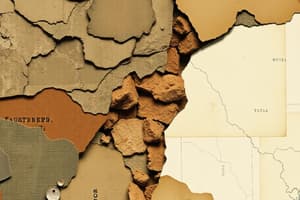Podcast
Questions and Answers
What is the primary process by which chemical reactions occur with oxygen in chemical weathering?
What is the primary process by which chemical reactions occur with oxygen in chemical weathering?
- Reduction
- Hydration
- Oxidation (correct)
- Hydrolysis
What is the term used to describe acids that fall to Earth from the atmosphere?
What is the term used to describe acids that fall to Earth from the atmosphere?
- Acid precipitation (correct)
- Atmospheric acid
- Acid rain
- Groundwater acid
How do living organisms contribute to chemical weathering?
How do living organisms contribute to chemical weathering?
- They produce strong acids that break down rocks
- They create oxygen that reacts with rocks
- They absorb acids from the atmosphere
- They produce weak acids that weather the rock surface (correct)
What is the primary result of chemical reactions with oxygen in rocks?
What is the primary result of chemical reactions with oxygen in rocks?
What is the role of groundwater in chemical weathering?
What is the role of groundwater in chemical weathering?
What is the term used to describe the breakdown of rocks by chemical reactions?
What is the term used to describe the breakdown of rocks by chemical reactions?
What is the common feature of all types of chemical weathering?
What is the common feature of all types of chemical weathering?
What is the process of moving sediments and other materials from one place to another?
What is the process of moving sediments and other materials from one place to another?
What is the name of the flat area formed by the deposition of many layers of sediments?
What is the name of the flat area formed by the deposition of many layers of sediments?
What is the name of the fan-shaped deposit that forms on dry land?
What is the name of the fan-shaped deposit that forms on dry land?
What is the term for the water located within the rocks below Earth's surface?
What is the term for the water located within the rocks below Earth's surface?
What are the two forces that shape a shoreline?
What are the two forces that shape a shoreline?
What is the term for the place where land and a body of water meet?
What is the term for the place where land and a body of water meet?
Flashcards are hidden until you start studying
Study Notes
Chemical Weathering
- Chemical weathering is the breakdown of rocks by chemical reactions that change the composition and appearance of rocks.
Types of Chemical Weathering
- Chemical weathering occurs through four types of reactions: reaction with oxygen, reaction with acid precipitation, reaction with acids in groundwater, and reaction with acids in living things.
Reaction with Oxygen
- Oxygen reacts with compounds that make up rocks, causing chemical reactions.
- This process is called oxidation.
- A color change can indicate that a chemical reaction has taken place.
Reaction with Acid Precipitation
- Acids in the atmosphere are created when chemicals combine with water in the air.
- When these acids fall to Earth, they are called acid precipitation.
- Acid precipitation can cause chemical weathering.
Reaction with Acids in Groundwater
- Water in the ground, or groundwater, can cause chemical weathering.
- As groundwater moves through spaces or cracks in rocks, acids in the water can cause rocks to dissolve.
Reaction with Acids in Living Things
- Acids are produced naturally by certain living organisms.
- Some living organisms grow on rocks and produce weak acids that can weather the rock surface as they grow.
Erosion and Deposition
- Erosion is the process of moving sediments and materials from one place to another.
- Deposition is the process of dropping eroded material.
Streams and Landforms
- Streams can create canyons and valleys through erosion, such as the Colorado River creating the Grand Canyon.
- Floodplains are formed through deposition, where layers of sediments are deposited over flooded land, creating a flat area.
- Deltas are fan-shaped deposits that form in water, while alluvial fans are fan-shaped deposits that form on dry land.
- Both deltas and alluvial fans are formed through deposition.
Groundwater
- Groundwater is the water located within rocks below Earth's surface.
- Groundwater can shape landforms through both erosion and deposition.
Coastal Landforms
- Shoreline is the place where land and a body of water meet.
- Waves and currents are forces that shape a shoreline.
- Coastal landforms can be formed through both erosion and deposition.
- Examples of coastal landforms made by erosion include cliffs and arches.
- Examples of coastal landforms made by deposition include beaches and spits.
Studying That Suits You
Use AI to generate personalized quizzes and flashcards to suit your learning preferences.




